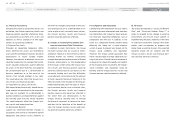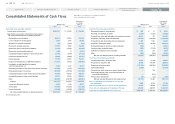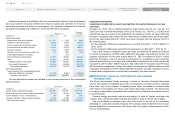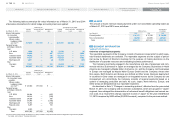Mazda 2015 Annual Report Download - page 51
Download and view the complete annual report
Please find page 51 of the 2015 Mazda annual report below. You can navigate through the pages in the report by either clicking on the pages listed below, or by using the keyword search tool below to find specific information within the annual report.
4 FINANCIAL INSTRUMENTS
Qualitative information on financial instruments
Policies for using financial instruments
The Group finances cash mainly through bank loans and the issuance of bonds, in light of
planned capital investment. Temporary surplus funds are managed through investments in
low-risk assets. Short-term operating funds are financed mainly through bank loans and
commercial paper. Our policies on derivative instruments are to use them to hedge risks,
as discussed below, and not to conduct speculative transactions.
Details of financial instruments and the exposures to risk
Trade notes and accounts receivable, while mostly due within one year, are subject to cus-
tomers’ credit risks. Accounts receivable denominated in foreign currencies are subject to
the risk of fluctuations in foreign currency exchange rates; such risk is hedged, in principle,
by netting the foreign-currency-denominated accounts receivable against accounts pay-
able, and applying foreign exchange forward contracts on the resulting net position.
Investment securities consist mainly of stocks of our business partner companies and
are subject to the risk of market price fluctuations and other factors. Long-term loans
receivable are provided mainly to our business partner companies.
Trade notes and accounts payable, as well as other accounts payable, are due within
one year. Of these payables, those denominated in foreign currencies are subject to the
risk of fluctuations in foreign exchange rates. However, the balance of such payables
denominated in major currencies is constantly less than that of the accounts receivable
denominated in the same foreign currency. For minor currencies where this does not apply,
such payables are hedged, as necessary, through foreign exchange forward contracts,
considering the transaction amounts and the degree of risk of foreign exchange rate
fluctuation.
Loans payable, bonds payable, and finance lease obligations are mainly intended for
financing cash required for capital investment. The longest time to maturity of these liabili-
ties is 57 years and 4 months from March 31, 2015. Of these liabilities, those of the vari-
able-interest-rate type are subject to the risk of interest rate fluctuations; part of them is
hedged through derivative transactions (interest rate swaps).
Derivative instruments consist of foreign exchange forward contracts and interest rate
swaps. For details on derivative instruments, refer to “Derivatives and hedge accounting”
under Note 2, “Significant Accounting Policies,” and Note 15, “Derivative Financial
Instruments and Hedging Transactions”.
Policies and processes for managing the risk
Management of credit risks (i.e., risks associated to the default of counterparties)
The Group manages credit risks, in compliance with internal control rules and procedures.
The due dates and the balances of trade notes, accounts receivable, and loans receiv-
able from major counterparties are monitored and managed, in order to detect early and
mitigate the risk of doubtful receivables.
Derivative transactions are executed only with banks with high credit ratings, in order to
mitigate counterparty risk.
For derivatives, the credit risks of counterparty financial institutions are reviewed on a
quarterly basis.
The amount of maximum risk as of March 31, 2015 is represented by the balance sheet
amount of financial assets exposed to credit risks.
Management of market risks (i.e., risks associated to fluctuations in foreign exchange
rates and interest rates)
The Company and some of its consolidated subsidiaries hedge the risk of foreign
exchange rate fluctuation on foreign-currency-denominated receivables and payables,
using foreign exchange forward contracts, on a monthly and individual currency basis.
Foreign exchange forward contracts are executed as necessary, up to six months ahead at
longest, on foreign-currency-denominated receivables and payables that are expected to
arise with certainty as a result of forecasted export and import transactions.
The Company and some of its consolidated subsidiaries use interest rate swaps in
order to reduce the risk of interest rate fluctuation on loans payable.
For details on management of derivative transactions, refer to Note 15, “Derivative
Financial Instruments and Hedging Transactions”.
As regards investment securities, their fair values as well as the financial standing of
their issuing entities are monitored on a regular basis. Ownership of available-for-sale
securities are reviewed on a continuous basis.
Management of liquidity risks related to financing (i.e., risks of non-performance of
payments on their due dates)
The liquidity risks of the Group are managed mainly through the preparation and update of
the cash schedule by the Treasury Department.
Mazda Annual Report 2015
49
C
CONTENTS
Growth Strategy
Message from Management
Introduction
Review of Operations
Foundations Underpinning
Sustainable Growth
























